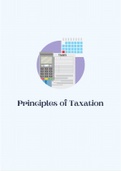Resume
Principles of Taxation Complete Summary (MBA BP - 2021)
- Cours
- Principles Of Taxation
- Établissement
- Katholieke Universiteit Leuven (KU Leuven)
A complete summary of the Principles of Taxation course for the Bridging Programme of KUL's MBA.
[Montrer plus]



